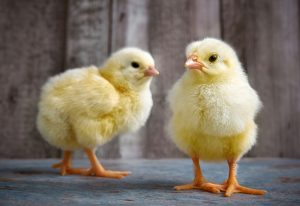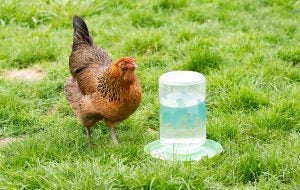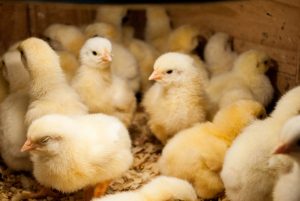With the arrival of spring, many people are on pins and needles about the weather, especially if there are more freezing temps in store. But knowing — at the very least — warm weather is right around the corner, I find myself eager to get creative and try some new things. Thankfully, my husband is pretty good about going along with whatever catches my fancy. A few years ago, that was chicks, so I had to do a deep dive on how to start baby chicks.
We’d been around cows and pigs, but never chickens. What do we need, how long do they take to grow, what equipment do we need to get? These were some of the first questions I had. After a little research, I felt prepared to get some birds. You’ll feel the same!
While this info isn’t geared toward someone who is building their livelihood off of poultry with a large-scale chicken facility, many other farmers and rural folks certainly are happy to have a few hens in the coop out back and fresh eggs for breakfast every morning. If you’re one of those and eager to get some chickens for your family, hopefully you can put this advice to good use and know what to think about beforehand:
Where do I put the chicks?
Before even stepping foot in a store, or buying off the internet, decide where you’re going to put them. Baby chicks need a nice warm spot. A stock tank is a great place to put them while they grow.
When they are ready to move outside, think about proximity to your house or other structures. Keep in mind, whether you use an existing building or build or buy a portable chicken coop like an old stock trailer, it needs to be tight so predators can’t slip in and demolish your flock. It’s always nice to be able to let your flock free-range, but just as nice to have a covered run that the birds can be safe in when they aren’t free-ranging. Keep in mind having to haul water and feed to your flock. You want them close enough to a faucet that it’s not overwhelming to haul fresh water.
Our chicken trailer came with an automatic door, and we have found it’s worth every penny. The birds can go in and out without us being there. The door automatically raises in the morning and closes at night. We put some long days in, so it’s nice to know the birds are safe in bed after dark without us having to lock them in.

What chicks do I get?
Do you want meat birds or egg layers? Do you want straight runs (hens and roosters) or pullets (hens only)? Do you care what color eggs the chickens lay? Do you intend for them to be free range? Some breeds do better free ranging than others.
Some good breeds for egg layers are Amberlink, Ameraucanas, Barred Rock, Australorps, Wyandottes, Orpingtons, or Rhode Island Reds. Some good breeds for meat birds are Cornish Rocks, Freedom Rangers, Red Ranger, or Barred Cochin. These lists are not all-inclusive, of course.
Do some research on what you’re looking for. Some breeds can be multi-purpose. Some do better free ranging. Some are more protective, and some are more docile.
What equipment do I need?
First, a waterer and feeder. I like the ones that you can hang. It helps keep the feed and water off the floor and keep them cleaner. You can get a bag of starter chick feed to get rolling. It’s a nice all around feed to give them what they need. You can wean them off of it later on and put them on a layer pellet once they get bigger.

Next, a heat lamp. No matter if you get them in the middle of the summer, your chicks will need a heat lamp. I recommend getting a red bulb instead of the white or clear bulbs. The red is less harsh and doesn’t encourage pecking at each other as much.
You’ll also want some sort of bedding: old newspaper, wood chips, etc. Something that isn’t too light and dusty. Remember, your chicks are going to be in a tank, and healthy chicks are going to be moving a lot. You don’t want something that is putting off a bunch of dust every time they move.
After the first week, I recommend putting a flock block or similar product in the tank with them. These birds grow really fast. Their natural instinct it to peck. If they don’t have something to peck at, they’re going to go after each other. You can avoid that by using a red light and giving them something to do. These blocks work really great for that.
Also, as they grow, make sure the food is an all-around feed with everything they need in it. If it doesn’t have all the nutrients they need, they’ll try to find what they need and that’s normally in each other.
How do I know when they are ready to go outside?
The general rule of thumb is when they are fully feathered, then they are ready to go outside. I always recommend having a covered run, even if you plan on free-ranging a lot of the time. Chickens just look for ways to die, and having a place you can lock them in, but they can still get outside is really important. If you have a tight run, that littles can’t get out of once they are fully feathered, you should be good to let them out.
Let them get used to the run and where they are going to perch. Chickens learn where home is pretty quickly. After they are used to “going to bed” after a few days, they should be good to go. Even when you let them out to free range, they should know where to go back home to eat, drink, lay eggs and go to bed.

When will they start laying eggs?
Each breed is different, but six months is a good starting point. The eggs will be little at first and will grow with the hens. A trick to know who is laying and who isn’t. The chickens with pale legs are the ones that are laying. If they have vibrant yellow or dark colored legs, they probably aren’t laying.
What about biosecurity?
With the Highly Pathogenic Avian Influenza, biosecurity is important. Visit your state’s agricultural website of agricultural news sites like AGDAILY for all the latest information available.
It’s important to do your research, but having chickens can be a great hobby. Make sure you have a good home for them, give them good quality feed and water, and you should be getting fresh eggs in no time!
Kelsey Pagel is a Kansas farmer. She grew up on a cow/calf and row crop operation and married into another. Kelsey and her Forever (Matt) farm and ranch with his family where they are living their dream and loving most of the moments.



